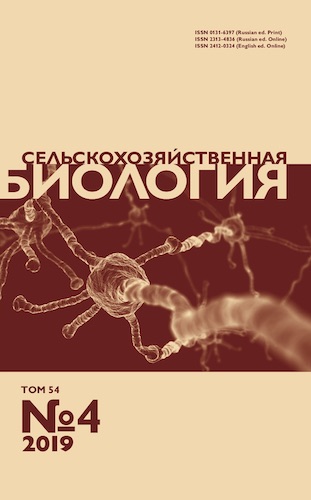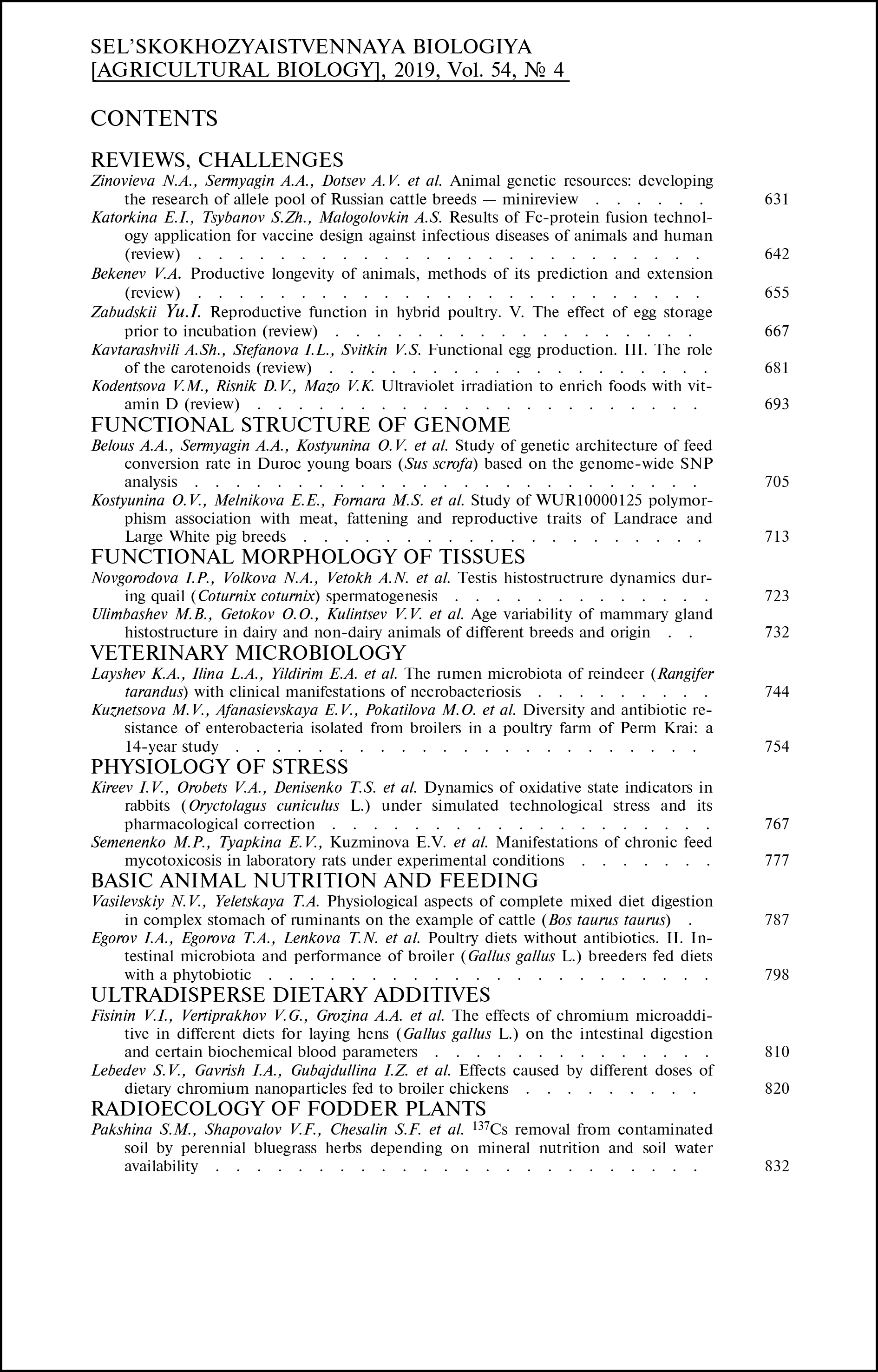doi: 10.15389/agrobiology.2019.4.777eng
UDC: 619:616-099:582.28
MANIFESTATIONS OF CHRONIC FEED MYCOTOXICOSIS IN LABORATORY RATS UNDER EXPERIMENTAL CONDITIONS
M.P. Semenenko1, E.V. Tyapkina1, E.V. Kuzminova1, A.G. Koshchaev2
1Krasnodar Research Center for Animal Husbandry and Veterinary Medicine, 4, ul. Pervomaiskaya, pos. Znamenskii, Krasnodar, 350055 Russia, e-mail sever291@mail.ru (✉ corresponding author);
2Trubilin Kuban State Agrarian University, 13, ul. Kalinina, Krasnodar, 350044 Russia, e-mail kagbio@mail.ru
ORCID:
Semenenko M.P. orcid.org/0000-0001-8266-5900
Kuzminova E.V. orcid.org/0000-0003-4744-0823
Tyapkina E.V. orcid.org/0000-0002-0520-0357
Koshchaev A.G. orcid.org/0000-0002-3904-2860
Received April 14, 2019
Mycotoxicoses are specific human and animal diseases caused by the certain types of microspores fungi that during their life form toxic substances, the mycotoxins. Toxic effects of these diseases are diverse and depend on the dose of toxin, exposure, animal species, age and sex. Lack of data on physiological mechanism of the pathological influence under combined mycotoxicoses significantly reduces the development of new drugs and methods for treatment of animal mycotoxicoses. This paper is our first report on the features of the clinical, biochemical, and pathomorphological signs of associative mycotoxicoses under experimental exposure of laboratory animals to the most common mycotoxins. The aim of the research was studying clinical signs of chronic combined mycotoxicosis and pathoanatomical changes in organs and tissues under experimental mycotoxins in laboratory rats, as well as the characteristics of intoxication symptoms, the effect of mycotoxins on the reproductive function of rats and their progeny, and morphobiochemical blood parameters. Experiments were carried out on 66 white non-linear rats of both sexes with a body weight of 80-120 g (Krasnodar Research Veterinary Institute vivarium, 2018). After 14-day acclimatization (quarantine) the rats matching experimental conditions were divided into two groups, 33 animals each, according to paired analogue criterium. The experimental rats were fed for 21 days with the feed naturally contaminated by mycotoxins. The control rats ate toxin-free feed. The spore counts in the contaminated feed was 5.7×104 for Fusarium sp., 1.2×104 for Mucor sp., and 2.0×104 for Penicillum sp. Mycotoxin concentration in the samples exceeded the maximum permissible level (3.6 mg/kg for zearalenone, 0.2 mg/kg for ochratoxin A, 6.2 mg/kg for fumonisin B1), which was confirmed by bioassay on laboratory animals (mice). During the experimental period, all animals were clinically monitored for general status, feed consumption, behavior, response to external stimuli, motor activity, skin and fur condition, tactile sensitivity, functions of the digestive and urinary organs, corneal and dermal reflexes, and dynamics of weight gain. Hematologic blood tests were also performed. At the end of the study, three rats were euthanized in the experimental group and three rats in control group to identify pathologic and anatomical changes. It was determined that toxic feed leads to a 21 % decrease in body weight compared to the control, and also negatively impacts upon ontogenesis and reproduction causing a higher number of stillborn offspring and lower body weight and vitality of the newborn rats. In the blood of experimental animals the number of erythrocytes decreases by 17.0 % (р ≤ 0.05), hemoglobin by 13.0 % (р ≤ 0.05), total protein by 23.7 % (р ≤ 0.01), glucose by 22.7 %, cholesterol by 28.9 %, and triglycerides by 22.7 % (р ≤ 0.05). Reactive leukocytosis developed as a response of leukopoiesis to intoxication and a possible allergic process. Activity of blood alanine and aspartate aminotransferases was 40.5 and 61.3 % (р ≤ 0.01) higher, respectively, compared to the control rats. We also revealed exudative hemorrhagic inflammation of the mucous membrane of the stomach, thin and thick intestine, swelling and plethora of the lungs, enlarged liver, kidneys and heart. Histological examination of liver tissues showed a decrease in the amount of glycogen in hepatocytes, as well as the areas with granular and fatty dystrophy, vacuolization of hepatocytes, proliferation of the bile ducts, which may indicate severe destructive and necrotic processes. In the kidneys, a granular and fatty dystrophy of the convoluted tubule epithelium, desquamation of epithelial cells and proliferation occur, in the heart there are changes in the transverse striations of fibers, problems with blood circulation in the heart muscle and endocardial thickening. A depletion of lymphoid elements and a decrease in the lymphatic follicles (malpighian bodies) are characteristic of spleen. Proliferation and mitosis of muscle cells are found in the uterus. Thus, the combined mycotoxicosis deeply violates the homeostasis of laboratory animals and leads to multiple pathological changes in the organs and systems of the body.
Keywords: mycotoxins, biochemical indicators of blood, laboratory rats, pathological anatomical studies, organs.
REFERENCES
- Ivanov A.V., Fisinin V.I., Tremasov M.Ya., Papunidi K.F. Mikotoksikozy (biologicheskie i veterinarnye aspekty) [Mycotoxicosis: biological and veterinary aspects]. Moscow, 2010 (in Russ.).
- Gruber-Dorninger C., Jenkins T., Schatzmayr G. Global mycotoxin occurrence in feed: a ten-year survey. Toxins (Basel), 2019, 11(7): 375 CrossRef
- Marczuk J., Obremski K., Lutnicki K., Gajęcka M., Gajęcki M. Zearalenone and deoxynivalenol mycotoxicosis in dairy cattle herds. Polish Journal of Veterinary Sciences, 2012, 15(2): 365-372 CrossRef
- The Mycotoxin Blue Book. D.E. Diaz (ed.). Nottingyam University Press, 2005.
- Gajęcka M., Zielonka Ł., Jakimiuk E., Dąbrowski M., Obremski K., Gorlo G., Mróz M., Gajęcki M. Diagnostic significance of selected analytical indicators of zearalenone mycotoxicosis in animals. Medycyna Weterynaryina, 2012, 68(9): 566-570.
- Tremasov M.Ya., Ivanov A.V., Papunidi K.Kh., Semenov E.I. Veterinarnyi vrach, 2010, 5: 16-19 (in Russ.).
- Mikhailova I.I., Evglevskaya E.P., Ryzhkova G.F., Mikhailova O.N. Mikotoksikozy krupnogo rogatogo skota [Cattle mycotoxicosis]. Zernograd, 2015 (in Russ.).
- Agol'tsov V.A., Popova O.M., Larionov S.V. Mikologiya i mikotoksikologiya v veterinarii i zootekhnii [Mycology and mycotoxicology in veterinary medicine and livestock]. Moscow, 2015 (in Russ.).
- Goliński P., Waśkiewicz A., Gromadzka K. Mycotoxins and mycotoxicoses under climatic conditions of Poland. Polish Journal of Veterinary Sciences, 2009, 12(4): 581-588.
- Streit E., Naehrer K., Rodrigues I., Schatzmayr G. Mycotoxin occurrence in feed and feed raw materials worldwide: long-term analysis with special focus on Europe and Asia. Journal of the Science of Food and Agriculture, 2013, 93(12): 2892-2899 CrossRef
- Changwa R., Abia W., Msagati T., Nyoni H., Ndleve K., Njobeh P. Multi-mycotoxin occurrence in dairy cattle feeds from the gauteng province of south Africa: a pilot study using UHPLC-QTOF-MS/MS. Toxins (Basel), 2018, 10(7): 294 CrossRef
- Velikanov V.V., Kurdeko A.P., Matsinovich A.A., Malkov A.A., Lapina V.A. Aktual'nye problemy intensivnogo razvitiya zhivotnovodstva (Gorki), 2009, 12(1): 78-86 (in Russ.).
- Izosimova I.V., Aksenov I.V. Uspekhi meditsinskoi mikologii, 2015, 14(7): 296 (in Russ.).
- Girish C.K., Devegowda G. Efficacy of glucomannan-containing yeast product (Mycosorb) and hydrated sodium calcium aluminosilicate in preventing the individual and combined toxicity of aflatoxin and T-2 toxin in commercial broilers. Asian-Australasian Journal of Animal Sciences 2006, 19(6): 877-883 CrossRef
- Berthiller F., Crews C., Dall’Asta C., Saeger S.D., Haesaert G., Karlovsky P., Oswald I.P., Seefelder W., Speijers G., Stroka J. Masked mycotoxins: a review. Moleculor Nutrition and Food Research, 2013, 57(1): 165-186 CrossRef
- Ivanov A.V., Tremasov M.Ya., Papunidi K.Kh., Chulkov A.K. Mikotoksikozy zhivotnykh (etiologiya, diagnostika, lechenie, profilaktika) [Mycotoxicosis of animals — etiology, diagnosis, treatment, prevention)]. Moscow, 2008 (in Russ.).
- Wada K., Endo H., Ogata Y., Ohtsuka H., Koiwa M., Nagahata H. Mycotoxins contamination of forage crops on a farm and attenuation of its harmful influence at three dairies. Japan Veterinary Medicine, 2007, 60: 425-429.
- Matveeva E.L. Uchenye zapiski Kazanskoi gosudarstvennoi akademii veterinarnoi meditsiny, 2006, 187: 19-23 (in Russ.).
- Donnik I.M., Bezborodova N.A., Bodrova O.S. Veterinariya Kubani, 2009, 1: 13-15 (in Russ.).
- Ravilov A.Z., Ugryumova V.S., Antipov V.A., Semenenko M.P., Vasil'ev V.F. Tekhnologiya zhivotnovodstva, 2010, 9-10: 11-14 (in Russ.).
- Seeling K., Dänicke S. Relevance of the Fusarium toxins deoxynivalenol and zearalenone in ruminant nutrition. Journal of Animal and Feed Sciences, 2005, 14(1): 3-40 CrossRef
- Sharma C., Aulerich R.J., Render J.A., Reimers T., Rottinghaus G.E., Kizilkaya K., Bursian S.J. Reproductive toxicity of ergot alkaloids in mink. Veterinary and Human Toxicology, 2002, 44(6): 324-327.
- Obremski K., Gajęcki M., Otrocka-Domagata I., Rotkiewicz T., Zwierzchowski W., Zielon-ka Ł., Mikołajczyk A., Siemionek J. Clinical case of rabbit zearalenone mycotoxicosis. Medycyna weterynaryina, 2005, 61(4): 458-461.
- Sokolova L.N. Klinicheskie i patomorfologicheskie proyavleniya subklinicheskikh mikotoksikozov u ptits [Clinical and pathomorphological signs of subclinical mycotoxicosis in birds]. St. Peterburg, 2008: 136-140 (in Russ.).
- Ulianitskaja A.Y. Veterinarnaya meditsina, 2008, 89: 376-381 (in Russ.).
- Zharov A.V., Belousov V.I., Barabanov I.I., Kalmykov M.V., Gulyukin M.I., Suvorov V.S., Yakovleva E.V. Metodicheskie ukazaniya po patogistologicheskoi tekhnike [Histopathological techniques — guidelines]. Moscow, 2005 (in Russ.).
- Verma R.J. Aflatoxin causes DNA damage. International Journal of Human Genetics, 2004, 4(4): 231-236 CrossRef
- Donnik I.M., Bezborodova N.A. Agrarnyi vestnik Urala, 2009, 8: 84-89 (in Russ.).
- Kozina E.A., Tabakov N.A. Vestnik KrasGAU, 2011, 7: 123-126 (in Russ.).
- Varga J., Frisvad J.C., Samson R.A. Two new aflatoxin producing species and an overview of Aspergillus section Flavi. Studies of Mycology, 2011, 69(1): 57-80 CrossRef
- Streit E., Schatzmayr G., Tassis P., Tzika E., Marin D., Taranu I., Tabuc C., Nicolau A., Aprodu I., Puel O., Oswald I.P. Current situation of mycotoxin contamination and co-occurrence in animal feed-focus on Europe. Toxins (Basel),2012, 4(10): 788-809 CrossRef
- Richard J.L. Some major mycotoxins and their mycotoxicoses — an overview. International Journal of Food Microbiology,2007, 119(1-2): 3-10 CrossRef
- Guerre P., Eeckhoutte C., Burgat V., Galtier P. The effects of T-2 toxin exposure on liver drug metabolizing enzymes in rabbit. Food Additives Contaminants, 2000, 17: 1019-1026 CrossRef
- Speijers G.J.A., Speijers M.H.M. Combined toxic effects of mycotoxins. Toxicology Letters, 2004, 153(1): 91-98 CrossRef
- Ismaiel A.A., Papenbrock J. Mycotoxins: producing fungi and mechanisms of phytotoxicity. Agriculture, 2015, 5: 492-537 CrossRef
- Liu B.H., Wu T.S., Yu F.Y., Su C.C. Induction of oxidative stress response by the mycotoxin patulin in mammalian cells. Toxicological Sciences, 2007, 95(2): 340 CrossRef
- Mary V.S., Valdehita A., Navas J.M., Rubinstein H.R., Fernández-Cruz M.L. Effects of aflatoxin B1, fumonisin B1 and their mixture on the aryl hydrocarbon receptor and cytochrome P450 1A induction. Food and Chemical Toxicology,2015, 75: 104-111 CrossRef
- Sun L.H., Lei M.Y., Zhang N.Y., Gao X., Li C., Krumm C.S., Qi D.S. Individual and combined cytotoxic effects of aflatoxin B1, zearalenone, deoxynivalenol and fumonisin B1 on BRL 3A rat liver cells. Toxicon, 2015, 95: 6-12 CrossRef












